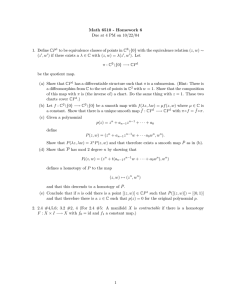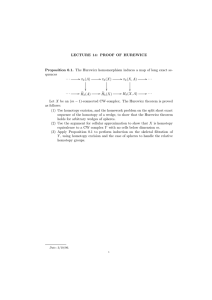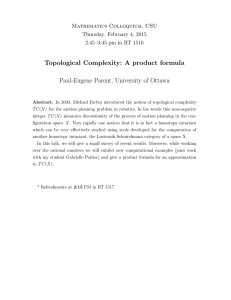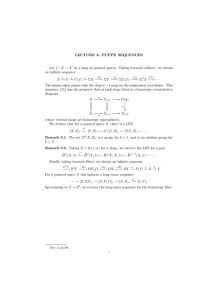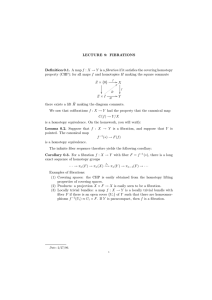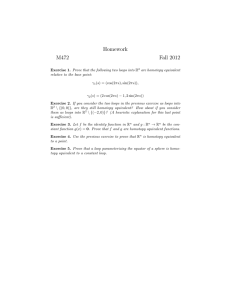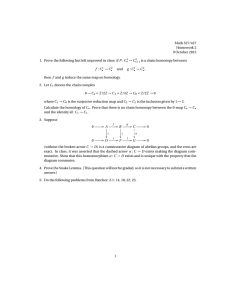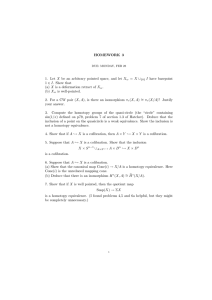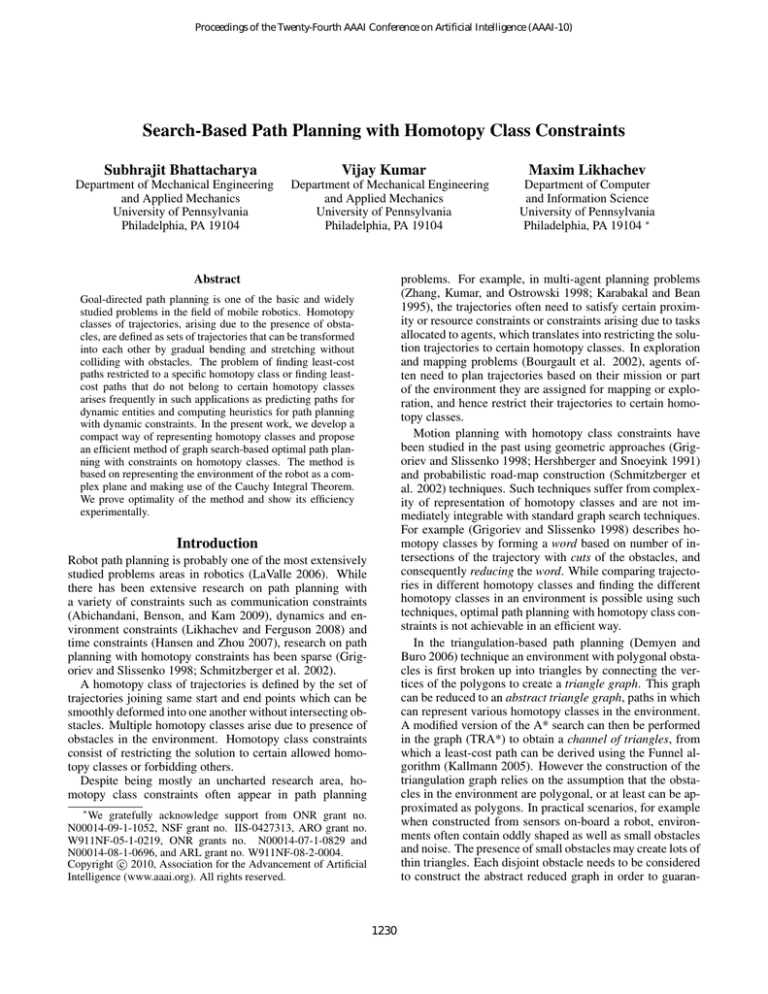
Proceedings of the Twenty-Fourth AAAI Conference on Artificial Intelligence (AAAI-10)
Search-Based Path Planning with Homotopy Class Constraints
Subhrajit Bhattacharya
Department of Mechanical Engineering
and Applied Mechanics
University of Pennsylvania
Philadelphia, PA 19104
Vijay Kumar
Department of Mechanical Engineering
and Applied Mechanics
University of Pennsylvania
Philadelphia, PA 19104
Abstract
Maxim Likhachev
Department of Computer
and Information Science
University of Pennsylvania
Philadelphia, PA 19104 ∗
problems. For example, in multi-agent planning problems
(Zhang, Kumar, and Ostrowski 1998; Karabakal and Bean
1995), the trajectories often need to satisfy certain proximity or resource constraints or constraints arising due to tasks
allocated to agents, which translates into restricting the solution trajectories to certain homotopy classes. In exploration
and mapping problems (Bourgault et al. 2002), agents often need to plan trajectories based on their mission or part
of the environment they are assigned for mapping or exploration, and hence restrict their trajectories to certain homotopy classes.
Motion planning with homotopy class constraints have
been studied in the past using geometric approaches (Grigoriev and Slissenko 1998; Hershberger and Snoeyink 1991)
and probabilistic road-map construction (Schmitzberger et
al. 2002) techniques. Such techniques suffer from complexity of representation of homotopy classes and are not immediately integrable with standard graph search techniques.
For example (Grigoriev and Slissenko 1998) describes homotopy classes by forming a word based on number of intersections of the trajectory with cuts of the obstacles, and
consequently reducing the word. While comparing trajectories in different homotopy classes and finding the different
homotopy classes in an environment is possible using such
techniques, optimal path planning with homotopy class constraints is not achievable in an efficient way.
In the triangulation-based path planning (Demyen and
Buro 2006) technique an environment with polygonal obstacles is first broken up into triangles by connecting the vertices of the polygons to create a triangle graph. This graph
can be reduced to an abstract triangle graph, paths in which
can represent various homotopy classes in the environment.
A modified version of the A* search can then be performed
in the graph (TRA*) to obtain a channel of triangles, from
which a least-cost path can be derived using the Funnel algorithm (Kallmann 2005). However the construction of the
triangulation graph relies on the assumption that the obstacles in the environment are polygonal, or at least can be approximated as polygons. In practical scenarios, for example
when constructed from sensors on-board a robot, environments often contain oddly shaped as well as small obstacles
and noise. The presence of small obstacles may create lots of
thin triangles. Each disjoint obstacle needs to be considered
to construct the abstract reduced graph in order to guaran-
Goal-directed path planning is one of the basic and widely
studied problems in the field of mobile robotics. Homotopy
classes of trajectories, arising due to the presence of obstacles, are defined as sets of trajectories that can be transformed
into each other by gradual bending and stretching without
colliding with obstacles. The problem of finding least-cost
paths restricted to a specific homotopy class or finding leastcost paths that do not belong to certain homotopy classes
arises frequently in such applications as predicting paths for
dynamic entities and computing heuristics for path planning
with dynamic constraints. In the present work, we develop a
compact way of representing homotopy classes and propose
an efficient method of graph search-based optimal path planning with constraints on homotopy classes. The method is
based on representing the environment of the robot as a complex plane and making use of the Cauchy Integral Theorem.
We prove optimality of the method and show its efficiency
experimentally.
Introduction
Robot path planning is probably one of the most extensively
studied problems areas in robotics (LaValle 2006). While
there has been extensive research on path planning with
a variety of constraints such as communication constraints
(Abichandani, Benson, and Kam 2009), dynamics and environment constraints (Likhachev and Ferguson 2008) and
time constraints (Hansen and Zhou 2007), research on path
planning with homotopy constraints has been sparse (Grigoriev and Slissenko 1998; Schmitzberger et al. 2002).
A homotopy class of trajectories is defined by the set of
trajectories joining same start and end points which can be
smoothly deformed into one another without intersecting obstacles. Multiple homotopy classes arise due to presence of
obstacles in the environment. Homotopy class constraints
consist of restricting the solution to certain allowed homotopy classes or forbidding others.
Despite being mostly an uncharted research area, homotopy class constraints often appear in path planning
∗
We gratefully acknowledge support from ONR grant no.
N00014-09-1-1052, NSF grant no. IIS-0427313, ARO grant no.
W911NF-05-1-0219, ONR grants no. N00014-07-1-0829 and
N00014-08-1-0696, and ARL grant no. W911NF-08-2-0004.
c 2010, Association for the Advancement of Artificial
Copyright Intelligence (www.aaai.org). All rights reserved.
1230
tee a collision-free path. Hence they contribute towards a
large number of homotopy classes, whereas we often may
only need to consider a few large obstacles for defining homotopy classes. Moreover the cost function in triangulationbased path planning is restricted to the Euclidean length of
the trajectory.
In this paper we propose a compact way of representing homotopy classes of trajectories which is independent
of the geometry, discretization, cost function or search algorithm. Our method is based on Complex Analysis and
exploits the Cauchy Integral theorem to characterize homotopy classes. We show that this representation can be seamlessly weaved into the standard graph search techniques in
arbitrarily discretized environments and impose the desired
homotopy class constraints. It is to be noted that the method
we propose is independent of the discretization scheme of
the environment, the nature of the cost function that needs
to be optimized, or the search algorithm used. Hence this
method can be incorporated into many existing planners,
giving them the capability of imposing homotopy class constraints. Also, we can choose not to include certain obstacles
if their sizes are too small for them to contribute towards
creating homotopy classes. We have demonstrated our algorithm on different environments of various sizes with grid
discretization as well as visibility graphs. Our experimental
results demonstrate the efficiency, scalability and applicability of the method.
(a) The integrals over (b) Only the poles enclosed
contours γ1 and γ2 are by γ influence the value of
equal
the integral of F .
Figure 1: Cauchi Integral Theorem and Residue Theorem
The scenario is illustrated in Figure 1(b).
It is important to note that in both the Cauchy Integral
Theorem and the Residue Theorem the value of the integrals
are independent of the exact choice of the contour γ as long
as the mentioned conditions are satisfied (see Figure 1(a)).
Representation of Homotopy Classes
Definition 1 (Homotopy Class of Trajectories). Two trajectories (or paths), τ1 and τ2 are said to be in the same
Homotopy Class iff one can be smoothly deformed into the
other without intersecting obstacles. Otherwise they belong
to different Homotopy classes.
We represent the 2-dimensional configuration space of
a robot by a complex plane, C. The obstacles are assumed to be simply-connected regions in C and are represented by O1 , O2 , · · · , ON . We define one “representative
point” per connected obstacle such that they lie in the interior of the respective obstacles. Thus we define the points
ζi ∈ Oi , ∀i = 1, · · · , N . Figure 2(a) shows such representative points inside three obstacles. As we will discuss
later, it is not necessary that we choose representative points
for all obstacles. We need to choose such points only on
the larger and relevant obstacles that contribute towards the
practical notion of homotopy classes. Smaller obstacles can
be disregarded.
Definition 2 (Obstacle Marker Function). For a given set
of “representative points”, we define the “Obstacle Marker
Function” function F as follows,
Complex Analysis
In this section we briefly review some of the fundamental
theorems of Complex Analysis (Gamelin 2001).
The Cauchy Integral Theorem The Cauchy Integral
Theorem states that if f : C → C is an Holomorphic (analytic) function in some simply connected region R, and γ
is a closed oriented (i.e. directed) contour completely contained in R, then the following holds,
I
f (z)dz = 0
(1)
γ
Moreover, if z0 is a point inside the region enclosed by γ,
which has an anti-clockwise (or positive) orientation, and
F (z) = f (z)/(z − z0 ) has a pole at z0 , then the following
holds
I
f (z)dz
= 2πif (z0 )
(2)
γ z − z0
F(z) =
l=1
(4)
where f0 is any analytic function over entire C.
Also, we define ∀i = 1, · · · , N ,
The Residue Theorem A direct consequence of the
Cauchy Integral Theorem, the Residue Theorem, states that,
if F : R → C is a function defined in some simply connected region R ⊆ C that has simple poles at the distinct
points a1 , a2 , · · · , aM ∈ R, and Holomorphic (analytic) everywhere else in R, and say γ is a closed positively oriented
Jordan curve completely contained in R and enclosing only
the points ak1 , ak1 , · · · , akm out of the poles of F , then the
following holds,
I
m
X
F (z)dz = 2πi
lim (ξ − akl )F (ξ)
(3)
γ
f0 (z)
(z − ζ1 )(z − ζ2 ) · · · (z − ζN )
fi (z) =
f0 (z)
(z − ζ1 ) · · · (z − ζi−1 )(z − ζi+1 ) · · · (z − ζN )
(5)
Thus, fi (z) = (z − ζi )F(z), is analytic inside regions that
do not contain ζ1 , · · · , ζi−1 , ζi+1 , · · · , ζN , but can contain
ζi .
Assumption 1. We note that for a given set of obstacles we
have significant amount of freedom in choosing the “representative points” inside the obstacles and the function f0 .
We assume that our choice of ζ1 , ζ2 , · · · , ζN and f0 satisfies
X
fu (ζu ) 6= 0
(6)
ξ→akl
u∈S
1231
Thus, by the Residue Theorem and Definition 2,
Z
Z
F(z)dz +
F(z)dz
−τ2
τ1
= 2πi
n
X
u=1
Z
Z
F(z)dz −
⇒
τ1
(a) In same Homotopy
class, forming a closed
contour
τ
and call it the L-value of the trajectory τ . Thus,
Lemma 3. The L-value of trajectories (connecting same
two points) in same homotopy class are equal, while the Lvalue of trajectories in different homotopy classes are different.
(7)
Proof. We note that by changing the orientation of a path
over which an integration is being performed, we change
the sign of the integral. If τ is a path, its oppositely oriented
path is represented as −τ . Thus, as we see from Figure 2(a),
τ1 along with −τ2 forms a positively oriented closed loop.
Moreover, since τ1 and τ2 lie in the same homotopy class,
the region enclosed by τ1 and τ2 does not contain any of
the “representative points”, ζi , hence rendering the function
F analytic in that region. Hence from the Cauchy Integral
Theorem we obtain,
Z
Z
F(z)dz +
F(z)dz = 0
Zτ1
Z−τ2
⇒
F(z)dz −
F(z)dz = 0
Search-based planning with Homotopy class
constraints
Our approach is to construct a graph by discretizing the environment and search it with any graph search algorithm such
as Dijkstra’s or A*.
The configuration space of a robot is represented by a directed graph G = (V, E). The nodes, of the graph represent
coordinates, (x, y), which when represented as a complex
number is z = x + iy ∈ V. Inaccessible states (obstacles or
states outside the workspace) do not constitute nodes. The
directed edges represent possible transitions from one state
to another and have weights or costs associated with each.
Figure 3 illustrates a simple uniform discretization of the
configuration space into an 8-connected grid, each cell representing a node of the Graph G, and the connectivities are
defined between neighboring cells. A path in the graph is
equivalent to a trajectory.
For a given graph, G = (V, E), for every edge e = {z1 →
z2 } ∈ E, assuming it to be a straight line segment, using the
substitution z = (1 − λ)z1 + λz2 , one can write
Z
L(e) =
F(z)dz
e
Z 1 =
F (1 − λ)z1 + λz2 (z2 − z1 ) dλ (10)
τ2
Hence proved.
Lemma 2. If two trajectories τ1 and τ2 connecting the same
points lie in different homotopy classes then the following
holds,
Z
Z
F(z)dz 6=
τ1
F(z)dz
fκu (ζκu )
l=u
Lemma 1 and 2 together imply that in a given environment, we can identify the homotopy classes of trajectories
by the value of the line integration of the Obstacle Marker
Function along the trajectory. For notational convenience
for a given trajectory, τ , we write
Z
L(τ ) = F(z)dz
(9)
τ2
τ1
τ2
n
X
Hence proved.
Lemma 1. If two trajectories τ1 and τ2 connecting the same
points lie in the same homotopy class then the following
holds,
Z
Z
F(z)dz
= 2πi
by Assumption 1
for any S ⊆ {1, 2, · · · , N }. While it is evident that it is very
unlikely that this condition will be violated in general case,
we can still enforce the conditions by checking the chosen
ζi ’s and f0 for every S. In the unlikely event that (6) is not
satisfied, we simply choose different ζi ’s and f0 .
F(z)dz =
F(z)dz
6= 0,
(b) In different Homotopy classes, enclosing
obstacles
Figure 2: Two trajectories in same and different homotopy
classes
τ1
lim (ξ − ζκu )F (ξ)
ξ→ζκu
(8)
τ2
Proof. If τ1 and τ2 are in different homotopy classes, we
can easily note that the closed positive contour formed by
τ1 and −τ2 will enclose one or more of the obstacles, and
hence their corresponding “representative points”. This is
illustrated in Figure 2(b). Let us assume that enclosed “representative points” are ζκ1 , ζκ2 , · · · , ζκn . Moreover we note
that the function F has only simple poles at ζ1 , ζ2 , · · · , ζN .
0
This integral for every e ∈ E can be computed numerically
for the graph G up to a desired numerical precision (Figure
3(b)). Alternatively, assuming e is small, one can use the
following analytical formulation to compute L(e).
1232
0
C, ln(z 0 ) = ln(|z 0 |ei(arg(z )+2kπ) ) = ln(|z 0 |) +
i (arg(z 0 ) + 2kπ) , ∀k = 0, ±1, ±2, . . . (where arg(x +
iy) = atan2(y, x)). Hence, following the assumption that e
consists of a small line segment, we choose the smallest of
all the possible values of L(e) as follows,
N
X
L(e) =
Al ln(|z2 − ζl |) − ln(|z1 − ζl |) + (13)
l=1
i arg(z2 − ζl ) − arg(z1 − ζl ) + 2kl π
where, kl is such that |arg(z2 − ζl ) − arg(z1 − ζl ) + 2kl π|
is minimized. This corresponds to finding the minimum angle between the vectors z2 − ζl and z1 − ζl .
The L-augmented Graph
Let zs = xs + iys be the start coordinate and zg = xg + iyg
be the goal coordinate. In the discussions that follow, by
referring to the L-value of a state z, we will refer to the Lvalue of a trajectory connecting zs to z. We note that the
L-value of a state can assume only certain discrete complex
numbers corresponding to the different homotopy classes of
trajectories from zs .
(a) Graph formed by uniform discretization of configuration space and connecting
each node with 8 neighbors
The Allowed and Blocked homotopy classes The planner is given one out of the two following sets of L-values for
the state zg (i.e. the L-value of trajectories joining zs to zg ):
i. The set of Blocked homotopy classes: This is a set of Lvalues corresponding to the homotopy classes of trajectories that the solution is not allowed to be in. It is represented by B = {β1 , β2 , · · · , βb }, where βl is essentially a
complex number representing the L-value of a homotopy
class of trajectories that connect zs and zg . We note that
B can be empty.
ii. The set of Allowed homotopy classes: This is a set of Lvalues corresponding to the homotopy classes of trajectories that the solution is allowed to be in. It is represented
by A = {α1 , α2 , · · · , αa }.
We note that A and B are essentially complement of each
other and cannot have any element in common. Thus, if U is
the set of all possible L-values of zg , B = U/A. Only one
out of A and B needs to be explicitly defined.
(b) An edge can be discretized
further to compute L(e)
Figure 3: Discretized environment.
For computing the L-value of e = {z1 → z2 } analytically, we assume that f0 is chosen to be a polynomial of
order N − 1. Then F(z) can be written as the following
partial fraction decomposition,
F(z) =
N
X
Al
z − ζl
(11)
The L-augmented Graph The identity of each state in G
is its coordinate z. We modify the graph, G, by appending
the L-value of each state z to it (i.e. L-value of a trajectory from zs to z). Thus a node in the Augmented Graph
is given by {z, L(zs → z)}, where zs → z represents a
trajectory from zs to z, and L(zs → z) is its L-value. We
note that the L-value appended to the state’s identity indicates the homotopy class of a path found from zs to z. For
a given coordinate z, the L in the augmented state {z, L}
can assume discrete values corresponding to the homotopy
classes of the trajectories joining zs to z. Thus, we define
the L-augmented graph of G as follows,
l=1
where, Al =
f0 (ζl )
N
(ζ −ζj )
j=1 l
j6=l
. Using some algebra and calculus
in complex plane we get from (10),
Z
L(e)
=
(z2 − z1 )
0
=
N
X
N
1X
l=1
Al
dλ
(z2 − z1 )λ + (z1 − ζl )
Al (ln(z2 − ζi ) − ln(z1 − ζl ))
(12)
l=1
GL (G) = {VL , EL }
However we note that the logarithm of a complex number does not have an unique value. For any z 0 ∈
where,
1233
Theoretical Analysis
Theorem 1. If PL∗ = {{z1 , Λ1 }, {z2 , Λ2 }, · · · , {zP , ΛP }}
is an optimal path in GL , then the path P ∗ =
{z1 , z2 , · · · , zP } is an optimal path in the graph G satisfying the Homotopy class constraints specified by A and B
Sketch of Proof. By construction of GL , the path
{z1 , z2 , · · · , zP } (which is the projection of PL∗ on G) satifies the given Homotopy class constraints. Moreover by definition, PL∗ is a minimum cost path in GL . Since the cost
function in GL is the same as the one in G and does not involve Λ, it follows that the projection of PL∗ on G given by
P ∗ = {z1 , z2 , · · · , zP } is an optimal path in the graph G
satisfying the Homotopy class constraints used to construct
GL .
Figure 4: The topology of the augmented graph, GL (right),
compared againt G (left), for a cylindrically discretized configuration space around a circular obstacle
1.
z ∈ V, and,
Λ∈
/ B (or equivalently, Λ0 ∈ A)
if z = zg , and,
VL = {z, Λ}
Λ = L(z → z) for some trajectory
s
zs → z, from zs to z
Illustrative Example Figure 5 demonstrates an example
where we used a 50 × 50 uniformly discretized environment
with a single obstacle (with ζ1 = 27.5 + 32.5i marked with
circle inside the obstacle). Each node in the graph, G, is connected to its 8 neighbors. Thus the orientation of trajectory
segments are constrained to multiples of 45◦ only. Start is at
the bottom left point (1, 1) in the environment, and the goal
is on the top-right (45, 45).
Figure 5(a) shows projection of the optimal path (shown
in solid color) returned by A* search in GL without any homotopy class constraint. The tree in dashed color shows the
expanded states and their connection to the parent nodes.
The L-value of the trajectory is found to be 52.15 + 85.97i
and the total number of states expanded was 1011.
Next we block the homotopy class corresponding to Lvalue of 52.15 + 85.97i (i.e. set B = {52.15 + 85.97i}
and plan the trajectory once again in GL . Thus we obtain a
solution in a different homotopy class 5(b). The L-value of
the new trajectory is found to be −105.77 − 65.57i and the
total number of states expanded was 1721.
As we can see from the figure, the blocking of a homotopy
class made the search algorithm expand some extra states to
find the solution in another homotopy class. However as
we observe, the number of extra expansions is small. This
is because during the exploration of states in the blocked
homotopy class a large proportion of states in the desired
homotopy class gets expanded as well.
Also, it is to be noted that the exploration of the homotopy
classes can be performed in a single run of graph search.
This can be achieved by keeping on expanding the states
in the L-augmented graph uninterruptedly, and noting down
the states in the graph that correspond to the goal coordinates.
Figure 5(c) demonstrates what happens when we block
both homotopy classes of trajectories that reach the goal
from two sides of the obstacles. The trajectory we hence
obtain is a non-Jordan curve (the one that intersects itself)
that loops around the obstacle. If we keep searching while
blocking one homotopy class after another, we will obtain
least-cost trajectories in different homotopy classes in the
order of their pathcosts. This includes non-Jordan curves.
Now imagine the scenario when we have a ζi set inside
a very small obstacle near the start and far from the goal
state. The expansion of states will result in a large number
2. And, edge {{z, Λ} → {z 0 , Λ0 }} is in EL for {z, Λ} ∈ VL
and {z 0 , Λ0 } ∈ VL , iff
i. {z → z 0 } ∈ E, and
ii. Λ0 = Λ + L(z → z 0 ), where L(z → z 0 ) is the L-value
of the straight line segment joining the adjacent nodes
z and z 0
3. And, the cost/weight associated with an edge {{z, Λ} →
{z 0 , Λ0 }} ∈ EL is same as the cost of the edge {z → z 0 } ∈
E.
The topology of this augmented graph is illustrated in
Figure 4. A goal state zg is the same in G irrespective for
the path (τ1 or τ2 ) taken to reach it. Whereas in the Laugmented graph, the states are differentiated by the additional value of Λ. We can perform a graph search in the
augmented graph, GL , using any standard graph search algorithm starting from the state {zs , 0 + i0}. The goal state
(i.e. the state, upon expansion of which we stop the graph
search) is any of the states {zg , α} for any α ∈ A (or
α∈
/ B if B is provided instead of A). We can use the same
heuristic that we would have used for searching in G, i.e.
hL (z, Λ) = h(z). It is to be noted that GL is essentially an
infinite graph, even if G is finite. However the search algorithm needs to expand only a finite number of states. Since
for a given z, the states {z, Λ} can assume some discrete values of Λ (corresponding to the different homotopy classes),
to determine if {z, Λ} and {z, Λ} are the same states, we can
simply compare the values of Λ and Λ.
In our experiments we used both numerical (equation
(10)) and analytical (equation (13)) approaches for computing the L-value of the edges. For the numerical integrations
we chose 0.01 cell units as the step-size. For checking the
equality of two L-values of a particular state, L1 and L2 ,
we check if ||L1 − L2 || < for some small . It is to be
noted that for a particular state there are only discrete (generally widely separated) L-values corresponding to the discrete homotopy classes. Thus for all practical purposes we
can safely keep quite high.
1234
(a) No
homotopy
class
constraint
(b)
B = {52.15 +
85.97i}.
(a)
(c) Non-Jordan
curve.
B={}
(b)
B={−409.76+
2557.70i}.
(c)
B={−409.76+
2557.70i,567.90+
2220.77i}.
Figure 6: Exploring homotopy classes by blocking the class
obtained from previous search
Figure 5: Paths found and states expanded by A* search
without and with homotopy class constraints
of loops around the small obstacle which will reduce the efficiency of the algorithm. Hence it’s important that we choose
the ζi carefully only inside relevant (large) obstacles which
influence our notion of homotopy class of the trajectories.
Experimental Analysis
(a) Key-point generated
trajectory. L-value =
1530.94 + 531.55i.
In all of the following examples, except for the one with visibility graph, the state graph, G, is generated by uniformly
discretizing a rectangular configuration space and then connecting each node with its 8 neighboring nodes. The search
algorithm used for searching in GL was A*. The heuristic
used for the search was same as the heuristic for searching
in G. In our implementation the real and imaginary parts
of L-values are floating point numbers forming a 2-element
vector representing coordinates in the plane where we are
planning the trajectories.
The functional form of f0 was chosen as f0 (z) = (z −
BL)a (z − T R)b , where BL and T R represent the complex
coordinates of the bottom-left and the top-right points of the
environment. We chose integer a and b such that |a − b| ≤ 1
and a + b = N − 1. This lets us use the analytical formulation of (13) in computing L(e). (But we have also tested
the numerical integration of (10), and the results are identical except for longer run-time due to numerical integration).
This functional form of f0 , which is analytic, is chosen so
that the function F (and hence the L-values) scale well with
the size of the environment and number of obstacles. Moreover such a function will almost always make sure that Assumption 1 holds. The ζi are chosen to be the points closest
to the centroid of Oi and lying inside it (shown as circles in
the figures 5-12).
(b) Optimal trajectory
with A = {1530.94 +
531.55i}.
Figure 7: Homotopy class constraint determined using suboptimal key-point generated trajectory.
Multiple robot visibility problem
The problem of path planning for multiple robots with visibility constraints can also make use of our approach. If one
robot needs to plan its path such that it is never obstructed
from the view of another robot by some obstacle, we can apply the homotopy class technique to obtain the desired trajectories. In Figure 8(a)-(c) two robots plan trajectories to
their respective goals. The robot on the right needs to plan a
trajectory such that it is in the “visibility” of the robot on the
left, whose trajectory is given. Thus, in order to determine
the L-value of the desired homotopy class it first constructs a
suboptimal path by connecting its own start and goal points
to the start and goal of the left robot, such that the trajectory
of the left robot is completely contained in it (Figure 8(b))
as key points. The L-value of this path gives the desired
homotopy class, thus re-planning with that class as the only
allowed class gives the desired optimal plan (Figure 8(c)).
Path prediction by homotopy class exploration
In order to demonstrate the scalability of our algorithm we
constructed 10 large 1000 × 1000 environments using random circular and rectangular obstacles. The implementation
Single robot trajectory planning
As described in the illustrative example section, Figures
5 and 6 demonstrate exploration of homotopy classes by
blocking them one after another. For the example in Figures 6 (a), (b) and (c) the number of states expanded in
the searches are 990, 1097 and 1622 respectively. Figure 7
demonstrates a similar example where we define homotopy
classes using a sample (suboptimal) trajectory specified by
key-points Figure 7(a). One can then compute the L-value
for such a trajectory. It can then be used to search GL for an
optimal path in the same homotopy class (or different) as the
sample trajectory (Figure 7(b)).
(a)
Unconstrained plans of
two robots
(b)
Robot 2 determines L-
value of desired hmtp. class
(c)
Optimal plan with visi-
bility constraint satisfied
Figure 8: 100 × 100 discretized environment with 2 representative points on the central large connected walls
1235
(a)
(a) Paths in 20 different
homotopy classes
(b)
w = 0.0, B = {}
w = 0.01, B = {}
(b) Run-time & states
expanded
for
finding
the least-cost paths in a
particular run
Hmtp.
time ellapsed until ith
states expanded
class
hmtp. class explored (s)
cumulative (106 )
(i)
min
max
mean
min
max
mean
1
1.41
2.01
1.71
0.021 0.039 0.032
2
3.58
8.58
5.15
0.099 0.313 0.170
3
5.09
9.69
6.77
0.180 0.375 0.244
4
6.13
12.46
8.92
0.237 0.494 0.345
5
7.80
17.74 11.50 0.285 0.776 0.472
6
10.53 18.56 13.05 0.422 0.825 0.555
7
10.92 19.74 15.38 0.473 0.888 0.681
8
13.35 20.32 17.01 0.604 0.935 0.773
9
15.08 21.76 18.60 0.693 1.027 0.858
10
15.53 26.28 20.87 0.720 1.252 0.978
(c) Statistics of searching least-cost paths in first 10 homotopy
classes in 10 randomly generated environments. The numbers represent the cumulative values till the ith homotopy class is explored.
(c)
w
=
0.0, B
{−8.41 + 8.41i}
=
(d)
w
=
0.01, B
=
{−8.41 + 8.41i}
Figure 10: Planning with non-Euclidean length as cost as
well as homotopy class constraint
Thus, in this case, besides the transition costs of the states in
G, each state, z = x + iy ∈ G, is assigned a cost w · x, the
penalty on separation from the communication base. Thus
the net penalized cost of theR trajectory,R τ , that is being minimized is of the form c = τ ds + w τ x(s)ds, where x is
the x-coordinate of the points on the trajectory, parametrized
by s, the length of the trajectory. The trajectories in figures
10(a) and (b) with penalty weights w = 0 and w = 0.01
respectively have L-values of −8.41 + 8.41i. Blocking this
homotopy class, but having a small penalty over distance
from communication base gives the trajectory in 10(d) that
passes close to the communication base.
Figure 9: Exploring homotopy classes in 1000 × 1000 discretized environments to find least cost paths in each
was done in C++ running on an Intel Core 2 Duo processor with 2.1 GHz clock-speed and 4GB RAM. Figure 9(a)
shows how for such an environment we can determine trajectories in different homotopy classes in order of their path
costs. All the different trajectories in different homotopy
classes were determined in a single run of graph search on
GL . Figure 9(b) and Table 9(c) demonstrate the efficiency
of the searches. The time indicates the cumulative time during the search until a shortest-path trajectory in a particular
homotopy class is found. This is relevant to problems of
tracking dynamic entities, such as people, where one often
needs to predict possible paths in order to bias the tracker
or to deal with occlusion by anticipating where the dynamic
entity will appear. Since people can choose different paths
to their destinations, we need to be able to predict least cost
paths that lie in different homotopy classes.
Planning with additional coordinates
In Figure 11, besides x and y, we have used time as a third
coordinate in G. There are two dynamic obstacles in the
environment - the one at the bottom only translates, while
one near the top both translates as well as expands in size.
We have two representative points on the two static obstacles. Figure 11(a) shows the solution upon blocking the first
homotopy class in the environment without the dynamic obstacles. Figure 11(b) shows the planned trajectory in the environment with dynamic obstacles (with the color intensity
representing the time coordinate). Figure 11(c-e) show the
execution of the trajectory at different instants of time of the
same. Figure 11(g-h) show the execution of the plan without
homotopy class constraint.
Arbitrary cost functions
Implementation using Visibility Graph
Our method is not limited to Euclidean length cost functions.
It can deal with arbitrary cost functions. For example, in
Figure 10 there are two large obstacles and a communication base to the left of the environment marked by the bold
dotted line, x = 0. An agent is supposed to plan its path
from the bottom to the top of the environment, while minimizing a weighted sum of the length of the trajectory and
the distance of the trajectory from the communication base.
To demonstrate the versatility of the proposed algorithm we
implemented it using a Visibility Graph as the state graph,
G. Figure 12 shows the visibility graph generated in an environment with polygonal obstacles and the shortest paths
in the first 9 homotopy classes. Obstacles were inflated in
order to incorporate collision safety and circular obstacles
were approximated by polygons. Representative points were
placed only on the large obstacles (determined by threshold
1236
plane. Using the proposed representation, we have shown
that homotopy class constraints can be directly weaved with
graph search techniques for determining optimal path constrained to certain homotopy classes or forbidden from others. We have proved the optimality of the method and have
experimentally demonstrated its efficiency, versatility and
several applications.
(a) No dynamic obstacles
References
(b) Dynamic obstacles
(c) t = 1
(d) t = 30
(e) t = 113
(f) t = 1
(g) t = 19
(h) t = 81
Abichandani, P.; Benson, H. Y.; and Kam, M. 2009. Multivehicle path coordination in support of communication. In
ICRA’09: Proceedings of the 2009 IEEE international conference on Robotics and Automation, 3839–3846. Institute
of Electrical and Electronics Engineers Inc., The.
Bourgault, F.; Makarenko, A. A.; Williams, S. B.; Grocholsky, B.; and Durrant-Whyte, H. F. 2002. Information based
adaptive robotic exploration. In in Proceedings IEEE/RSJ
International Conference on Intelligent Robots and Systems
(IROS, 540–545.
Demyen, D., and Buro, M. 2006. Efficient triangulationbased pathfinding. In AAAI’06: Proceedings of the 21st national conference on Artificial intelligence, 942–947. AAAI
Press.
Gamelin, T. W. 2001. Complex analysis. Springer Science.
Grigoriev, D., and Slissenko, A. 1998. Polytime algorithm for the shortest path in a homotopy class amidst semialgebraic obstacles in the plane. In ISSAC ’98: Proceedings
of the 1998 international symposium on Symbolic and algebraic computation, 17–24. New York, NY, USA: ACM.
Hansen, E. A., and Zhou, R. 2007. Anytime heuristic search.
Journal of Artificial Intelligence Research (JAIR) 28:267–
297.
Hershberger, J., and Snoeyink, J. 1991. Computing minimum length paths of a given homotopy class. Comput.
Geom. Theory Appl 4:331–342.
Kallmann, M. 2005. Path planning in triangulations. In
Proceedings of the IJCAI Workshop on Reasoning, Representation, and Learning in Computer Games.
Karabakal, N., and Bean, J. C. 1995. A multiplier adjustment method for multiple shortest path problem. Technical
report, The University of Michigan.
LaValle, S. M. 2006. Planning Algorithms. Cambridge, U.K.: Cambridge University Press. Available at
http://planning.cs.uiuc.edu/.
Likhachev, M., and Ferguson, D. 2008. Planning long
dynamically-feasible maneuvers for autonomous vehicles.
In Proceedings of Robotics: Science and Systems (RSS).
Schmitzberger, E.; Bouchet, J.; Dufaut, M.; Wolf, D.; and
Husson, R. 2002. Capture of homotopy classes with probabilistic road map. In International Conference on Intelligent
Robots and Systems, volume 3, 2317–2322.
Zhang, H.; Kumar, V.; and Ostrowski, J. 1998. Motion planning under uncertainty. In IEEE International Conference
on Robotics and Automation. Leuven, Belgium: IEEE.
Figure 11: Planning with time as an additional coordinate.
The postion of the agent is denoted by R in figures (c)-(h).
Figure 12: Exploring homotopy classes using a Visibility
Graph
on diameter and marked by blue circles in the figure) and
visibility graph was constructed. A* search was used for
searching the L-augmented graph. The implementation was
made in MATLAB. The average run-time of the search until
the 9th homotopy class was explored was 0.4 seconds and
about 100 states were expanded.
Conclusion
In this paper we have proposed an efficient way of representing homotopy classes of trajectories using the line integral of
“Obstacle Marker Function” over the trajectory in a complex
1237

